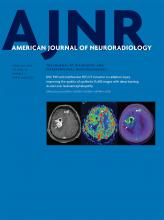Index by author
Maekawa, T.
- Adult BrainOpen AccessEffect of Gadolinium on the Estimation of Myelin and Brain Tissue Volumes Based on Quantitative Synthetic MRIT. Maekawa, A. Hagiwara, M. Hori, C. Andica, T. Haruyama, M. Kuramochi, M. Nakazawa, S. Koshino, R. Irie, K. Kamagata, A. Wada, O. Abe and S. AokiAmerican Journal of Neuroradiology February 2019, 40 (2) 231-237; DOI: https://doi.org/10.3174/ajnr.A5921
- EDITOR'S CHOICEAdult BrainOpen AccessImproving the Quality of Synthetic FLAIR Images with Deep Learning Using a Conditional Generative Adversarial Network for Pixel-by-Pixel Image TranslationA. Hagiwara, Y. Otsuka, M. Hori, Y. Tachibana, K. Yokoyama, S. Fujita, C. Andica, K. Kamagata, R. Irie, S. Koshino, T. Maekawa, L. Chougar, A. Wada, M.Y. Takemura, N. Hattori and S. AokiAmerican Journal of Neuroradiology February 2019, 40 (2) 224-230; DOI: https://doi.org/10.3174/ajnr.A5927
Forty patients with MS were prospectively included and scanned (3T) to acquire synthetic MR imaging and conventional FLAIR images. Synthetic FLAIR images were created with the SyMRI software. Acquired data were divided into 30 training and 10 test datasets. A conditional generative adversarial network was trained to generate improved FLAIR images from raw synthetic MR imaging data using conventional FLAIR images as targets. The peak signal-to-noise ratio, normalized root mean square error, and the Dice index of MS lesion maps were calculated for synthetic and deep learning FLAIR images against conventional FLAIR images, respectively. Lesion conspicuity and the existence of artifacts were visually assessed. The peak signal-to-noise ratio and normalized root mean square error were significantly higher and lower, respectively, in generated-versus-synthetic FLAIR images in aggregate intracranial tissues and all tissue segments. The Dice index of lesion maps and visual lesion conspicuity were comparable between generated and synthetic FLAIR images. Using deep learning, the authors conclude that they improved the synthetic FLAIR image quality by generating FLAIR images that have contrast closer to that of conventional FLAIR images and fewer granular and swelling artifacts, while preserving the lesion contrast.
Maitre, N.L.
- Pediatric NeuroimagingOpen AccessMR Imaging Scoring System for White Matter Injury after Deep Medullary Vein Thrombosis and Infarction in NeonatesK.L. Benninger, N.L. Maitre, L. Ruess and J.A. RusinAmerican Journal of Neuroradiology February 2019, 40 (2) 347-352; DOI: https://doi.org/10.3174/ajnr.A5940
Marroun, H.E.
- Pediatric NeuroimagingOpen AccessCavum Septum Pellucidum in the General Pediatric Population and Its Relation to Surrounding Brain Structure Volumes, Cognitive Function, and Emotional or Behavioral ProblemsM.H.G. Dremmen, R.H. Bouhuis, L.M.E. Blanken, R.L. Muetzel, M.W. Vernooij, H.E. Marroun, V.W.V. Jaddoe, F.C. Verhulst, H. Tiemeier and T. WhiteAmerican Journal of Neuroradiology February 2019, 40 (2) 340-346; DOI: https://doi.org/10.3174/ajnr.A5939
Martucci, M.
- Pediatric NeuroimagingYou have accessBrain DSC MR Perfusion in Children: A Clinical Feasibility Study Using Different Technical Standards of Contrast AdministrationS. Gaudino, M. Martucci, A. Botto, E. Ruberto, E. Leone, A. Infante, A. Ramaglia, M. Caldarelli, P. Frassanito, F.M. Triulzi and C. ColosimoAmerican Journal of Neuroradiology February 2019, 40 (2) 359-365; DOI: https://doi.org/10.3174/ajnr.A5954
Mathews, N.
- Head & NeckOpen AccessContrast-Enhanced 3D-FLAIR Imaging of the Optic Nerve and Optic Nerve Head: Novel Neuroimaging Findings of Idiopathic Intracranial HypertensionE. Golden, R. Krivochenitser, N. Mathews, C. Longhurst, Y. Chen, J.-P.J. Yu and T.A. KennedyAmerican Journal of Neuroradiology February 2019, 40 (2) 334-339; DOI: https://doi.org/10.3174/ajnr.A5937
Mayer, A.
- Pediatric NeuroimagingYou have accessVolumetric MRI Study of the Brain in Fetuses with Intrauterine Cytomegalovirus Infection and Its Correlation to Neurodevelopmental OutcomeA. Grinberg, E. Katorza, D. Hoffman, R. Ber, A. Mayer and S. LipitzAmerican Journal of Neuroradiology February 2019, 40 (2) 353-358; DOI: https://doi.org/10.3174/ajnr.A5948
Mckinney, A.M.
- FELLOWS' JOURNAL CLUBAdult BrainOpen AccessAcute Toxic Leukoencephalopathy: Etiologies, Imaging Findings, and Outcomes in 101 PatientsC. Özütemiz, S.K. Roshan, N.J. Kroll, J.C. Benson, J.B. Rykken, M.C. Oswood, L. Zhang and A.M. McKinneyAmerican Journal of Neuroradiology February 2019, 40 (2) 267-275; DOI: https://doi.org/10.3174/ajnr.A5947
Of 101 included patients, the 4 subgroups of >6 were the following: chemotherapy (n = 35), opiates (n = 19), acute hepatic encephalopathy (n = 14), and immunosuppressants (n = 11). Other causes (n = 22 total) notably included carbon monoxide (n = 3) metronidazole (n = 2), and uremia (n = 1). Acute hepatic/hyperammonemic encephalopathy clinically resolved in 36%, with severe outcomes in 23% (coma or death, 9/16 deaths from fludarabine). Notable laboratory results were elevated CSF myelin basic protein levels in 8/9 patients and serum blood urea nitrogen levels in 24/91. Acute toxic leukoencephalopathy is an imaging appearance that can arise from various etiologies, with potentially reversible reduced diffusion predominately affecting the periventricular WM. Given the shared DWI appearance among this heterogeneous array of etiologies, their outcomes may differ. Thus, the neurologic symptoms completely resolved in 36%, while severe outcomes occurred in 23%. The clinical outcome was most severe with chemotherapy-related ATL.
Meng, H.
- NeurointerventionOpen AccessOstium Ratio and Neck Ratio Could Predict the Outcome of Sidewall Intracranial Aneurysms Treated with Flow DivertersN. Paliwal, V.M. Tutino, H. Shallwani, J.S. Beecher, R.J. Damiano, H.J. Shakir, G.S. Atwal, V.S. Fennell, S.K. Natarajan, E.I. Levy, A.H. Siddiqui, J.M. Davies and H. MengAmerican Journal of Neuroradiology February 2019, 40 (2) 288-294; DOI: https://doi.org/10.3174/ajnr.A5953
Mohlenbruch, M.A.
- NeurointerventionYou have accessClinical Outcome after Thrombectomy in Patients with Stroke with Premorbid Modified Rankin Scale Scores of 3 and 4: A Cohort Study with 136 PatientsF. Seker, J. Pfaff, S. Schönenberger, C. Herweh, S. Nagel, P.A. Ringleb, M. Bendszus and M.A. MöhlenbruchAmerican Journal of Neuroradiology February 2019, 40 (2) 283-286; DOI: https://doi.org/10.3174/ajnr.A5920
Mokin, M.
- InterventionalOpen AccessHigh-Definition Zoom Mode, a High-Resolution X-Ray Microscope for Neurointerventional Treatment Procedures: A Blinded-Rater Clinical-Utility StudyS.V. Setlur Nagesh, V. Fennel, J. Krebs, C. Ionita, J. Davies, D.R. Bednarek, M. Mokin, A.H. Siddiqui and S. RudinAmerican Journal of Neuroradiology February 2019, 40 (2) 302-308; DOI: https://doi.org/10.3174/ajnr.A5922








